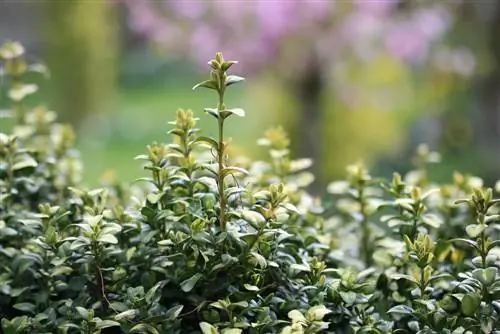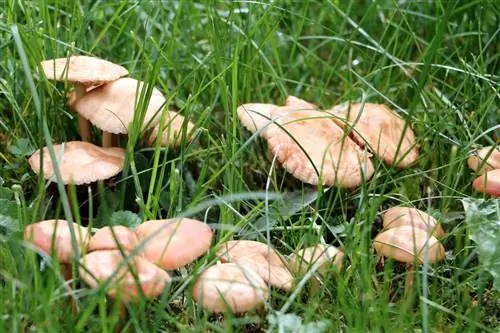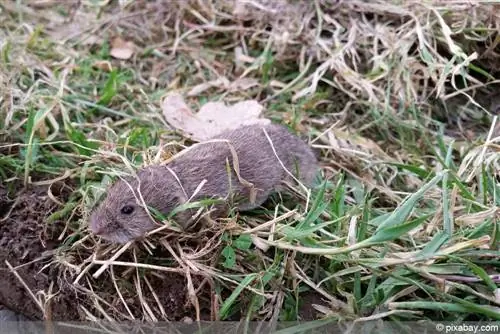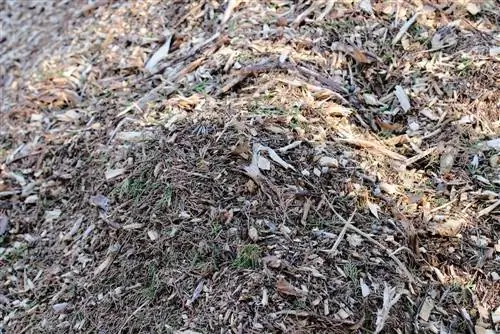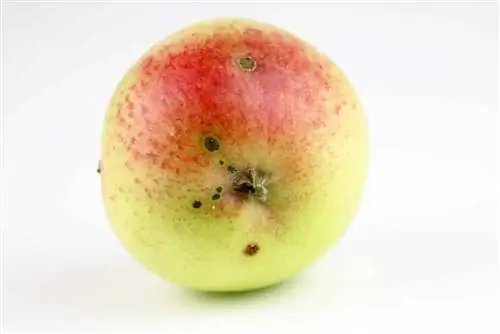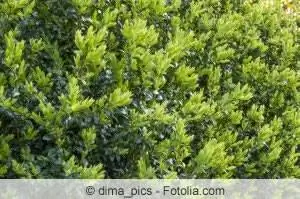- Author admin [email protected].
- Public 2023-12-17 03:39.
- Last modified 2025-01-24 12:45.
As fascinating and beautiful as boxwood trees may be in the garden or in the house, if they are attacked by the so-called boxwood flea, their glory can quickly be over. In fact, the pest is one of the biggest threats to boxwood of all kinds. Fortunately, it can be controlled quite easily. And without the use of mostly environmentally harmful chemicals.
malicious image
As an evergreen plant, the leaves of boxwood naturally play the central role. In a way, they make up his character. It is of course particularly unpleasant that the damage caused by flea infestation is particularly noticeable on the leaves. It is not for nothing that the pest is also called the boxwood psyllid. When an infestation occurs, the individual leaves of the tree curve either upwards or towards the underside like a spoon. The bends are the first clearly visible sign of an infestation. There are also white excreta, which are reminiscent of cotton wool in consistency and can usually be found on the leaf surface if you look closely. In an advanced stage, very sticky honeydew can appear, which then attracts further pests. As a result, the growth of the plant is usually significantly inhibited.
Tip:
A boxwood flea infestation often first appears at the tips of the shoots. Checking them regularly is therefore an important step in discovering the pest as early as possible.
Pests
The psyllid flea, whose Latin name is Psylla buxi, is very widespread in Europe. This of course increases the likelihood that a box tree in the garden will be attacked by the little offender. The flea itself is greenish in color and is around 3.5 millimeters in size. It also has wings and relatively strong jumping legs. Both allow it to move effortlessly from leaf to leaf and to quickly leave the plant completely in the event of a possible danger. However, the problem is not so much the adult flea, but rather its larvae, which are deposited on the leaf surface. They are greenish-yellow in color, are very flat and can be easily recognized by their black antenna tips. Most of the time they are covered by wax secretions. In order to get food, the larvae drill into the leaves with their proboscis, which then causes dangerous damage.
Combat

If an infestation of boxwood fleas is discovered, action should be taken immediately. As with other pests, the sooner they are controlled, the more successful the plant will be saved. There are basically two ways to combat this type of flea. On the one hand, you can use special pest control products from garden shops, and on the other hand, some home remedies work surprisingly well to get rid of the troublemaker quickly and effectively.
Pesticides
If you want to use pesticides or perhaps have to, you can rely on a whole range of products. However, these generally do not include any remedies that have been specifically developed against the psyllid. Rather, you choose between products that generally work against insect infestation - so-called insecticides. In order to be effective against this flea, they should contain one of the following active ingredients or a combination of several of these active ingredients:
- Azadirachtin
- Acetamiprid
- Pyrethrins
- Rapeseed oil
Anyone who uses chemicals against boxwood psyllids in the garden should be aware that they are also endangering other, certainly desirable insects. In view of the continuing extinction of species among insects in our latitudes, the step should therefore be carefully considered. The Chamber of Agriculture in North Rhine-Westphalia has also proven that the use of insecticides to combat boxwood flea is not necessary, but that there are effective alternatives
Home remedies
A very effective alternative to commercially available insecticides is soapy water. In a sense, it is something like the classic home remedy for controlling pests on plants. Soap suds are very easy to make yourself and are also significantly cheaper than any chemical product. It is important that either soft soap or very small pieces of soap are dissolved in warm water. Only warm water guarantees a quick and complete solution process. Once the soap is completely dissolved, let the lye cool. Then use a cloth or sponge to remove the boxwood flea from the leaves of the boxwood one by one.
Admittedly, this takes some time, but it protects the environment and your wallet.
Tip:
If you collect small soap residues that are no longer suitable for washing your hands throughout the year, you will always have enough stock to make soap suds if needed.
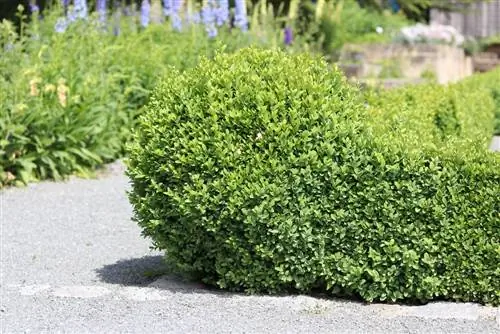
After a leaf has been cleaned, the cloth should always be wrung out in clear water. The goal is simply to not let pests get into the bucket of soapy water.
Cutting
However, there is a relatively simple and very environmentally friendly alternative to soapy water - and that is an additional cut. As a rule, the belly tree flea lays eggs on the leaves in the months of July and August. If you discover fleas or their clutches on the shoot tips of the tree during this time, it is advisable to cut off the affected shoots thoroughly. Basically, the entire tree can be subjected to a second topiary. In most cases this is urgently necessary, as cutting off individual shoots inevitably leads to the tree losing its shape. Under no circumstances should the cut shoots be disposed of in the compost, otherwise there is a great risk of renewed infestation. It's better to go into the closed garbage can.
Prevention
Even if the boxwood flea is relatively easy to combat, you should still do everything you can to prevent an infestation with the culprit in the first place. It probably cannot be prevented completely and forever. And in contrast to other pests, it usually appears when all requirements regarding location, soil and care have been met. However, there is one measure that has a preventative effect - namely significant pruning in autumn. Here you can and should approach the matter boldly. On the one hand, this strengthens the plant. On the other hand, it also means that any previously undetected infestation is guaranteed to be eradicated. The following applies: Prevention is better than cure.

